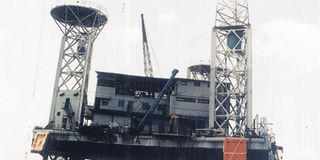Town hosts historic space station

PHOTO | FILE The offshore San Rita space platform is one of the smaller sites that make up the Luigi Broglio Space Centre in Malindi.
What you need to know:
- That there is a satellite launch platform in Kenya that has been used since the 1960s to send satellites and rockets to space is not known by many
In May 1967, some local Banjunis and Italians assembled off the coast of Malindi to watch a historic moment. For the first time in the world, and in Kenya, a satellite was being launched from a sea-borne pad.
“It was an improbable event of the space age,” wrote Life magazine of May 1967, while capturing the dramatic events of that day.
The 285kg satellite was powered by a 20-tonne Scout rocket, a family of American built launch vehicles that had been made to send small satellites into orbit.
That there is a satellite launch platform in Kenya that has been used since 1960s to send satellites and rockets to the space is hardly known.
The Luigi Broglio Space Centre comprises an offshore launch site, the San Marco Platform, which is actually a former oil platform, and a ground communication station in Malindi’s Ras Ngomeni village. There are two smaller platforms known as Santa Rita (also a former oil platform) and Santa Rita II. They are all connected by undersea cables.
A miniature version of the US Kennedy Space Centre, the choice of Malindi was apt. First, researchers were fascinated by the possibility of building a space station near the Equator.
They knew that a sea platform near the Equator would assure them of a favourable climate. Also, the space to the east (the direction to which space satellites are launched) was free and again, the Italians who were financing the project felt that by having their own space station, they would have a primary position in space research.
The idea of building this station in Malindi was sold to the Italian government by Luigi Broglio, a civil engineer who had also earned a second degree in Aeronautical Engineering.
Prof Broglio recalled in an 1967 interview that he floated the idea to some NASA scientists visiting Italy over a lunch date. “They almost choked on their lasagna… They said, ‘You certainly are a brave man.’ I think it was a polite way of saying, ‘You are crazy!’”
A man who had been involved in the building of the first Italian jet plane project, Broglio was fascinated by the launch of the Sputnik in 1957 by the Soviets. He wanted Italy to also join the race since only USSR and US had been competing for that glory.
It was through his efforts that in 1964 Italy launched the San Marco 1 satellite in cooperation with NASA, becoming the third country to enter the space race.
As the President of School of Aeronautical Engineering, Broglio thought of the possibility of creating a space station near the Equator. That is how Malindi was chosen. It was near a good port, Mombasa and near the equator.
The Kenya government gave the Italians some 3.5 hectares to build the station, 35 kilometres from Malindi.
A renewable inter-governmental agreement was signed on January 1, 1963. The site also gave researchers a chance to control satellites from land.
But it was from Malindi station that the famous X-ray astronomy satellite named Uhuru was launched on December 12, 1970. Also known as the X-ray Explorer Satellite, it was the first to fully survey the entire sky for X-ray sources.
Luigi Broglio became a constant feature in Malindi in the 60s, when he helped launch more than 10 satellites from the platform.
The satellites were launched on behalf of Italy, US and UK. It was in this facility that the Italian San Marco D/L satellite was launched.
The station was almost abandoned when space research suffered further after man landed on the moon.
NASA reduced its budget for San Marco project, leaving the two bases (one in the Ocean and the other mainland) in the hands of Italy’s National Research Centre (where Broglio was the president) until 1967 when they were taken over by the University La Sapienza, Rome.
Since 2004, the facility has been run by the Italian Space Agency.
In April last year, the government was challenged in Parliament to state the status of the project after the agreement expired. The house was informed that the two governments were holding negotiations to renew the contract.
One of the controversies has been about how much Kenya was gaining by hosting the facility after the government said the Italian government had disbursed only Sh240 million to the community since 1964.
“The station has been used as a ground station for reception, processing and archiving of satellite data. This is a multi-billion dollar business in the world today…why is it that the government has not been able to make money out of that multi-billion dollar business?” asked Dr Wilbur Otichilo, holder of a PhD in space science.
Some MPs wanted the government to take over the mainland facility since of the 240 Kenyans employed there, only four held managerial positions.




